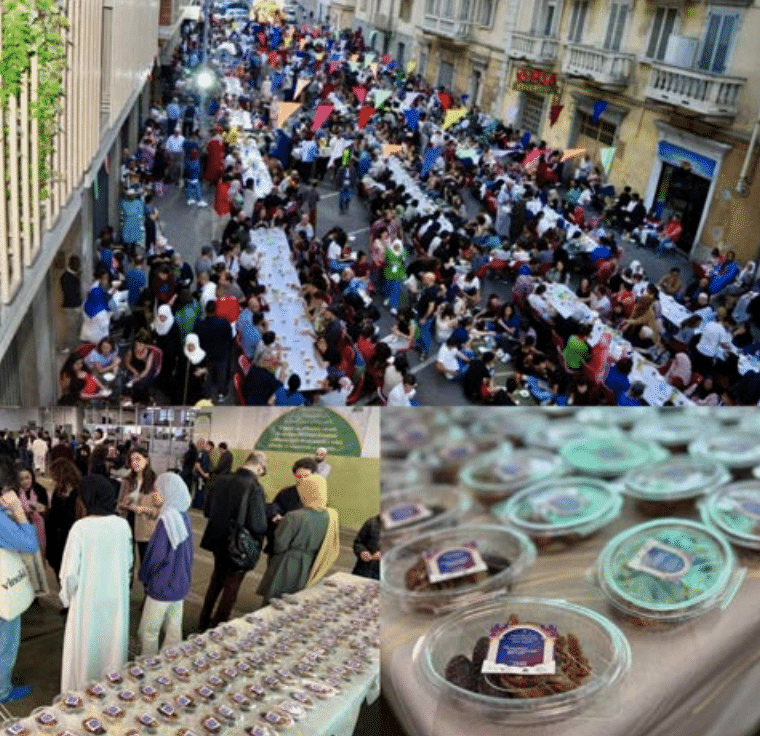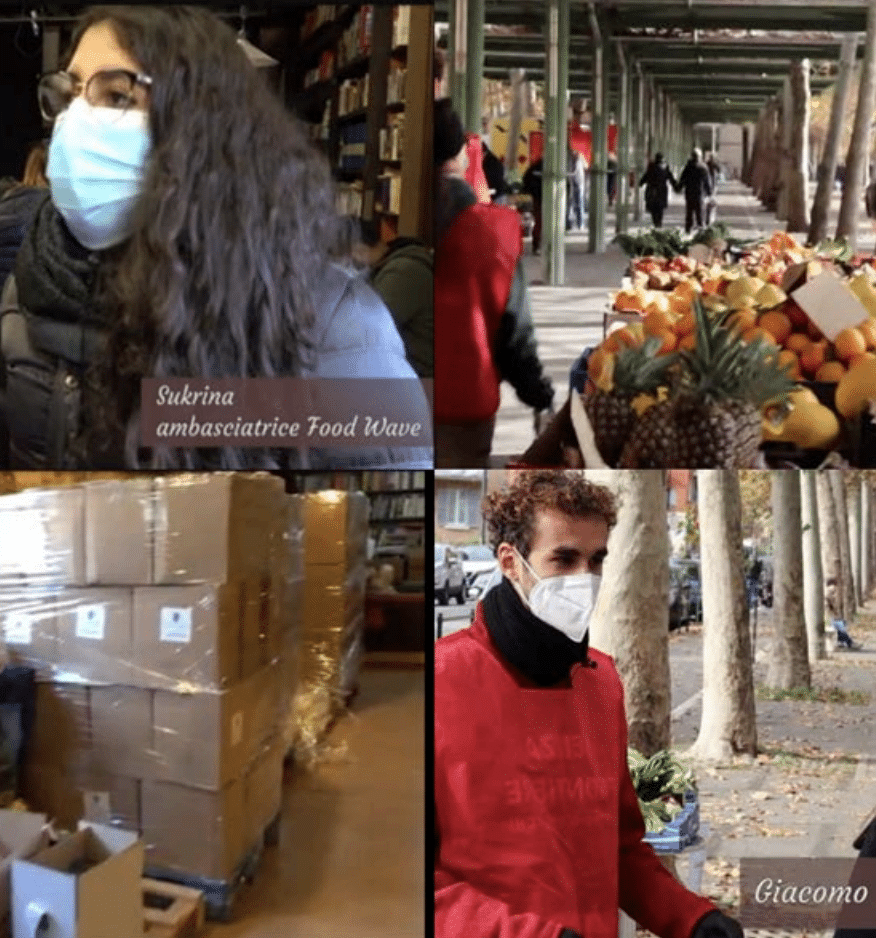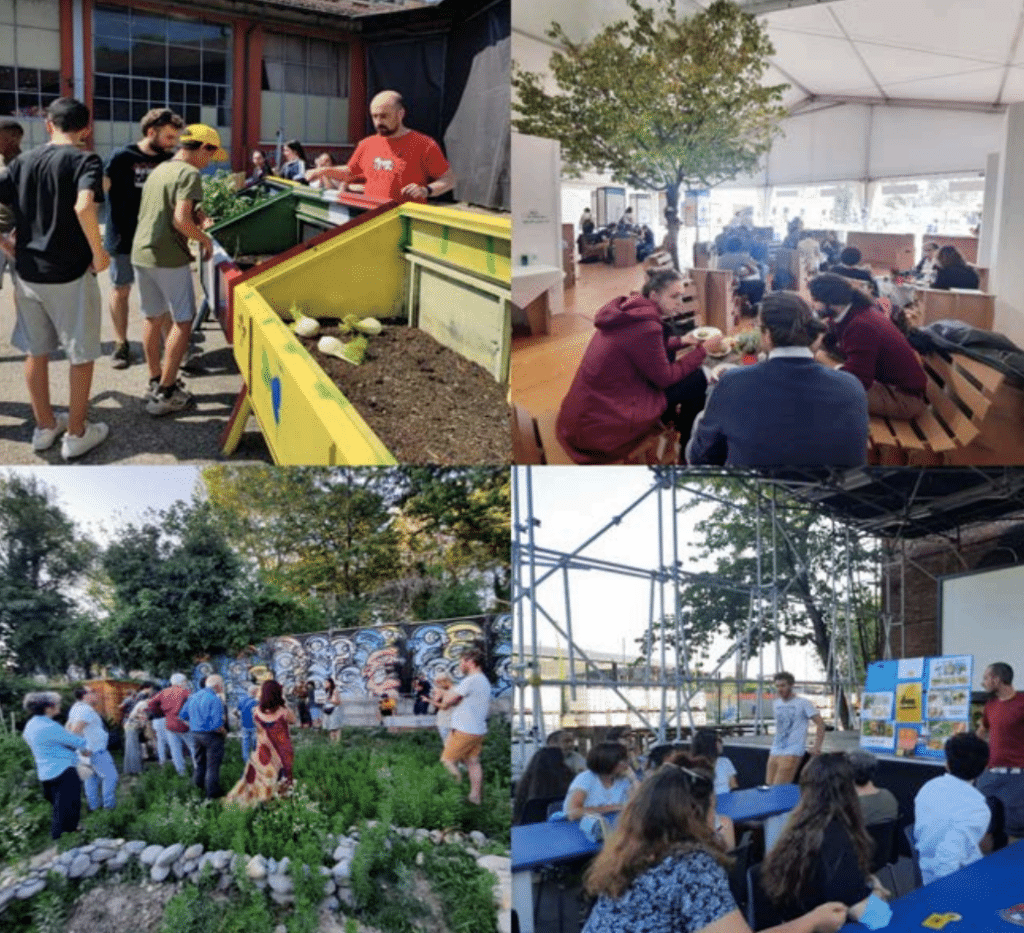Maria Bottiglieri
International cooperation, peace and global education
Città di Torino, Turin, Italy
maria.bottiglieri@comune.torino.it
1. From a religious dimension of the Right to adequate food to a spatial aspect of the religious Right to food
From a multi-religious extent, the access to food has contributed to build a diverse identity of the
European food culture since the Middle Ages1:
- The Christian religion contributed to carrying over the classical/roman culture of bread, wine and oil, to which a symbolic value was attributed;
- The Islamic culture helped spreading new agricultural techniques, new plants (such as sugar cane, citrus fruits, aubergines and spices), new dishes (such as the couscous) also introducing new ‘tastes’ (e.g.: sweet and sour)2;
- The Jewish food culture significantly influenced the European gastronomic culture as evidenced by the food ‘alla giudia’, a food that was not necessarily kosher, but which ‘in its ingredients, taste and appearance was immediately recognisable by all as typically Jewish and different from a similar dish produced by Christians’3.
National and international Human Rights charters, defining the Right to adequate food as it follows, currently protect the cultural dimension of access to food:
“The Right to have a regular, permanent and free access, either directly or through financial purchases, to quantitatively and qualitatively adequate and sufficient food corresponding to the cultural traditions of the people to which the consumer belongs, and which ensures a physical and mental, individual and collective, fulfilling and dignified life free of fear4.
Nevertheless, the international charters protecting the Right to adequate food (firstly, Article 25 Universal Declaration of Human Rights and Article 11 International Covenant on Economic, Social and Cultural Rights) are not directly recognising its religious dimension. In fact, this is often interpreted as a cultural aspect of this Right, and only made explicit by second-level sources, prohibiting discrimination of access to food for religious reasons (as General Comment No. 12).5 The first time a UN document used the word belief (but not faith) as a criterion for the compatibility of dietary regimes was only in the 2014 International Conference on Nutrition6.
Surprisingly, the prohibition against the discrimination of people’s access to food on religious grounds, is not directly protected, nor by the European charters of Human Rights, nor by any national law, such as the Italian Constitution7. In the European Union law, for example, the Right to eat meat by slaughtering rituals is not ruled by on religious freedom grounds but on animals’ protection grounds, within which slaughtering rituals are considered a derogation to animals’ welfare principles, recognised in order to respect religious rites8. In the Council of Europe system, thanks to case law the “Right to religious adequate Food” has begun to be guaranteed9.
On the other hand, it should be noted that, while there are laws and religious rules regulating places of worship, there is less attention paid to non-cult spaces, where believers exercise their religious freedoms. However, non-worship spaces can more easily be proposed as places of dialogue and encounters between believers of different faiths.
Public space helps determine the relationship between people and places and helps create a sense of belonging, community and wellbeing. That’s why public space is also crucial to the development of the spatial dimension of the religious Right to food for at least two reasons:
- the natural vocation of public spaces such as urban gardens, popular kitchens, school canteens, food hubs, and public markets to meet different food cultures10;
- the neutral nature of these spaces, which as such, support the meeting of food cultures expressing different religious traditions.
2. The Right to adequate food as key of an intercultural and inter-religious use of public space
“You don’t know a person until you eat with them”, says an old Arab saying. This saying underlines the need to find time and space to sit around a table, look into each other’s eyes, and share food, even with people you do not yet know but can begin to discover and appreciate11.
In many cities, such as Turin, there are public spaces in which citizens of different faiths can meet and share food on daily basis12:
- Public schools, where school dinners, available according to different dietary rules, constitute a further educational moment and an opportunity to get to know other cultural and religious food traditions;
- Outdoor public food markets, where the offer of foodstuff produced according to the different religious food rules is concentrated in the same space;
- Food aid centres: Charity is a common rule to all religions, and doing charity together does not pose cultic issues as a common prayer may.
This paper will present specific projects developed before, during and after the pandemic that highlight the different use of public space and commons.
3. “Turin Open city” – the practices
“Moscheeaperte”and “Torinoplurale”are two good experiences to describe how food became one of the primary tools for bringing together communities, people and religions:
Two different practices (one born before and the other during the pandemic) with two distinct focuses (faith and charity) and with different post-pandemic outcomes that, together, present Turin as an open city.
3.1 Knowing the faiths via the food route: Open Mosque
In 2016, the City of Turin signed the first Pact with representatives of all the Islamic communities in Turin (the pact was renewed in 2023).
This initiative had the most significant expression in the public celebration of Eid Al-Fitr (the end of Ramadan), hosted under the former roof of an industrial building undergoing urban regeneration.
Open mosques, promoted during Ramadan, is a moment of gathering around food open to all citizens. The Islamic communities invite all citizens to learn about Islamic life by guided tours of the mosque: exhibition stands on various themes (Arabic calligraphy, henna tattoos, Muslim spirituality), tastings of typical Ramadan specialities.
Before the Pandemic, the main activity of the Open Mosque was the community Iftar – the festive Ramadan meal – shared in public streets at sunset and offered by Muslim communities to all believing and non-believing citizens of the city of Turin.
Open Mosques was suspended during the pandemic due to the impossibility of meeting and eating together.
Open Mosques returned in 2023, in a new way, by reintroducing the mosque’s cultural activities and offering mono-doses of Ramadan food. The choice not to reintroduce the shared Iftar along the streets may be attributed two factors: the persistence of the virus with the stricter rules for mass catering and the increased post-pandemic costs of energy and foodstuffs, which are two essential components for cooking.13

Figure 1: Open Mosque before and post Pandemic (Collage by MB, thanks Taiba Mosque pic)
3.2 Practicing food charity: Torino plural
In 2020, thirty associations (from Islamic, African, Chinese, and other ethnic communities, including many of those promoting Open Mosques) signed an agreement with Turin Municipality to implement the Torino plural project. The main objective was to support food aid during the pandemic time. By increasing the distribution of food aid, it has been possible to support proximity actions to vulnerable population groups. Turin plural, born in the middle of the pandemic, intercepts the “grey zone” (people and families that, for various reasons, are not yet entitled to Social Services, due to recent or irregular migration).
Torino plural project was promoted in addition to the official initiative of food supply and distribution, organised during the pandemic, by the City council with other Christian and lay charities and institutions14, reaching thousands of individuals and families in a difficult situation (except the grey zone).15

Figure 2: Youth Volunteers during Pandemic (Collage by MB, thanks Food Wave videos for Città di Torino)
After the pandemic, thanks to the Pacts renowned in 2022, Torino plural continued their activities to promote social integration with the network of Neighbourhood houses (which had been among the food hubs during the pandemic), going beyond food aid and focusing on paths of community growth.16
The public spaces often remained the same used during the pandemic however, the set up changed.
The young perspective on the Torino plural experience is shown by the self-produced videos of youth volunteers (aged 15-35) involved by some Torino plural partners, made thanks to the European project Food Wave.17The videos tell the young reaction to the lockdown discomfort through positive and volunteering Food aid actions aimed at feeling helpful to others.
After the pandemic, also thanks to the young network, food (and youth) returned to occupy food public spaces in a new way and with new projects: urban gardens, city markets, youth centres, walls, fairs, and commons18.

Figure 3: Youth Activists post Pandemic (Collage by MB, thanks MB and Città di Torino pic)
4. Opening up to hope
The above Food practices show how the Mosques, the Churches, the network of ethnic communities, and the youth associations are the main actors (not only the beneficiaries) in an inter-religious dialogue throughout food and public space.
These Turin good practices are the result and possibly a summary of years experimenting local policies in different areas:
- Intercultural and inter-religious local public policies19.
- Projects and policies focused on public space and commons as key for social inclusion20.
- Countless international practices, projects and policies related to food21.
The above experiences have also influenced local laws. Turin is indeed the first Italian city to recognize, in its basic Charter, the Right to adequate food in its environmental, health, social, urban, and commercial dimensions and in its cultural and religious approach. In particular, Turin is the first Italian local authority that directly recognizes the protection of the religious dimension of the Right to food. These local practices, policies and laws open up the hope that the interfaith and multicultural use of public space, through food, can foster new paths and resilient patterns of community.
1 Massimo Montanari, “Modelli alimentari e identità culturali,” in Storia dell’alimentazione, eds. Massimo Montanari and Jean Louis Flandrin (Laterza: Roma-Bari, 2007), 246- 249. See more: Maria Bottiglieri, “Il diritto al cibo adeguato. Tutela internazionale, costituzionale e locale di un diritto fondamentale nuovo,” POLISWorkingPapers222 (august 2015), chapters 1, 7, 10, https://iris.uniupo.it/retrieve/e163b88f-db9c- c12c-e053-d805fe0a7f21/PDF%20M.%20Bottiglieri%20tesi%20di%20dottorato.pdf
2 Bernard Rosenberger, “La cucina araba e il suo apporto alla cucina europea,” in Storiadell’alimentazione, eds. Massimo Montanari and Jean Louis Flandrin (Laterza: Roma-Bari, 2007), 278-279.
3 Ariel Toaff, “Cucina ebraica, cucine ebraiche,” in Ilmondoincucina,ed. Massimo Montanari (Laterza: Roma-Bari, 2002), 138.
4 Commission on Human Rights, The Right to food. Report by the Special Rapporteur on the Right to food, Mr. Jean Ziegler, 7 February 2001, Doc.U.N. E/CN.4/2001/53, paragraph 14, www.un.org/unispal/document/auto-insert-187548/ ; see more: Jean Ziegle, Christofe Goaly, Claire Mahon and Sally Ann Way, The Fight for the Right to Food (Palgrave Macmillan: London, 2011).
5 See more CESCR, “General Comment No. 12: The Right to Adequate Food (Art. 11),” Report on the twentieth and twenty-first sessions (26 April-14 May 1999, 15 November-3 December 1999), E/2000/22 E/C.12/1999/11, Economic and social council official records, Supplementn.2(UN: New York – Geneva, 2000), 102-110: www.un.org/esa/documents/ecosoc/docs/2000/e2000-22.PDF
6 See more FAO, The Second International Conference on Nutrition: Committing to a future free of malnutrition. (Rome on 19-21 November 2014), Better nutrition, better lives, 2015: www.fao.org/3/i4465e/i4465e.pdf
7 Maria Bottiglieri, “Diritto al cibo adeguato e libertà religiosa nella Costituzione italiana,” Orientamentisociali sardi 1 (2015): 33-59; Maria Bottiglieri, “The protection of the Right to adequate food in the Italian Constitution,” Forum di Quaderni Costituzionali – Rassegna 11 (2015): 3 https://www.forumcostituzionale.it/wordpress/wp-content/uploads/2015/11/bottiglieri.pdf.
8 Council Regulation(EC) No 1099/2009 of 24 September 2009 on the protection of animals at the time of killing, eur-lex.europa.eu/legal-content/EN/ALL/?uri=CELEX%3A32009R1099
9 See more: Recommendation Rec(2006) 2-rev of the Committee of Ministers to member States on the European Prison Rules, par. 22, rm.coe.int/09000016809ee581; Case of Jakóbski vs. Polonia (Application n. 18429/06), 3 March 2011, https://hudoc.echr.coe.int/fre#{%22itemid%22:[%22001-102121%22]} ; Maria Bottiglieri, “Il ‘diritto al cibo adeguato’ e l’alimentazione dei detenuti: tra tortura e trattamento inumano degradante,” in Le nuove giustificazioni della tortura nell’età dei diritti, eds. Marco Di Giovanni, Cinzia Rita Gaza, Gabriella Silvestrini (Morlacchi: Perugia, 2017), 307-324.
10 About relationship between public space and citizens in order to Right to Food, see more: Maria Bottiglieri, “Dal diritto alla città del cibo, l’Urban Food Policy. Verso nuove forme di partnership pubblico-privata,” in Cibo, spazi urbani, cittadini. Verso un’amministrazione condivisa dell’Urban food policy di Torino – Primo Quaderno Labsus, eds. Daniela Ciaffi, Francesca De Filippi, Giulia Marra, Emanuela Saporito (December 2016), 46-49, www.labsus.it or www.comune.torino.it/benicomuni/bm~doc/cibo-cittadini-e-spazi-urbani.pdf
11 Slow Food, Le ricette del dialogo. Storie e cibi di una società inclusiva(Bra: Slow Food, 2019) www.slowfood.it/wp-content/uploads/2019/10/17x24_cm_ricettario_migranti.pdf
12 About the Turin experience, see more: Giuseppe Valperga, “Ecumenica,” in Cibo e città. Atti del I workshop del progetto europeo “4cities4dev. Access to good, clean, fair food: the food community experience, Torino 3-4 Novembre 2011, eds. Maurizio Baradello, Maria Bottiglieri, Laura Fiermonte, Paolo Mascia (Anci Comunicare: Roma, 2012), 90-93: www.comune.torino.it/cooperazioneinternazionale/biblioteca/pdf/cibo_e_citta.pdf
13 Open Mosque videos:
- pre pandemia (Italian, subtitled in English and Arabic): www.youtube.com/watch?v=48eE4rnS4-Q); (Italian, subtitled in Arabic): www.youtube.com/watch?v=IBDPQj6h60E
- post pandemia (Italian) www.facebook.com/CentroTaiba/videos/1659257867861315
14 Food Wave – Empowering Urban Youth for Climate Action, foodwave.eu The videos on pandemic food aid in Turin (Italian, subtitled in English):
- The volunteers tell about pandemic time: www.youtube.com/watch?v=jxqAQBcmslo
- The Sara’s tell: www.youtube.com/watch?v=beNEzBlfQYM
- The Giacomo’s tell: www.youtube.com/watch?v=RHsthLKRkTA
- The Food wave ambassador: www.youtube.com/watch?v=PHTswbvuhcA
15 See more on: servizi.comune.torino.it/inclusione/torino-solidale/
16 Actionaid (ed.), La Pandemia che affama l’Italia. Covid-19, povertà alimentare e diritto al cibo, 2020, 26, actionaid.imgix.net/uploads/2020/10/Report_Poverta_Alimentare_2020.pdf
17 See more on: www.retecasedelquartiere.org/torino-plurale/
18 See more on: https://www.facebook.com/TurinInternationalCooperation/videos/541358744696467
19 I.e. Turin Spirituality (www.torinospiritualita.org/) or the Interfaith Committee of the City of Turin (www.interculturatorino.it/approfondimenti/comitato-interfedi-della-citta-di-torino/).
20 See more Turin Urban lab activities (urbanlabtorino.it/?lang=en) and Turin projects about Commons (www.comune.torino.it/benicomuni/eng_version/index.shtml).
21 Giacomo Pettenati and Alessia Toldo, “Part Two, Practices, Projects and Policies,” in Toward the Turin Food Policy. Practices and visions, eds. Maria Bottiglieri, Giacomo Pettenati and Alessia Toldo (FrancoAngeli: Milano, 2016), 36-159, series.francoangeli.it/index.php/oa/catalog/book/156



